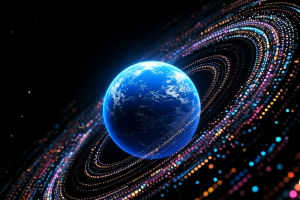Hey Lykkers, have you ever wondered if there’s more to the universe than what we can see, touch, or even measure? Well, science says yes—and one of the most fascinating concepts being explored right now is the idea of shadow particles.
These aren’t ghosts or fantasy—they’re a theoretical possibility that could change how we understand everything from dark matter to alternate dimensions. Let’s break it down.
What Are “Shadow Particles”?
Shadow particles are part of a hypothesis rooted in mirror matter theory, which suggests that for every known particle in our universe, there could be a “mirror” version of it in a hidden sector—a kind of parallel universe that interacts with ours primarily through gravity.
This idea was first proposed in the 1950s, but gained serious attention in the 1990s when physicists like R. Foot and S.N. Gninenko revisited the concept to help explain dark matter.
According to this theory, these mirror particles would have their own mirror atoms, mirror photons, even mirror stars and galaxies. They wouldn’t interact with our matter via electromagnetism (so we couldn’t see or touch them), but they would influence us gravitationally—possibly helping explain why galaxies rotate the way they do even though we don’t see enough mass.
How Does This Relate to Dark Matter?
Great question. Dark matter is one of the biggest mysteries in astrophysics. It makes up about 27% of the universe (compared to just 5% for ordinary matter), but we haven’t been able to detect it directly.
One idea is that dark matter is mirror matter—meaning it’s made of shadow particles. These particles wouldn’t emit light, making them invisible to our telescopes, but they’d have mass, explaining the gravitational pull we observe in galaxies.
Experiments like the DAMA/LIBRA project in Italy have picked up unusual signals that some scientists think could be due to mirror matter interacting with regular matter under rare conditions. However, these findings are still debated and not universally accepted in the physics community.
Can We Actually Detect Shadow Particles?
This is the million-dollar question. Because shadow particles wouldn’t interact with us through electromagnetic forces (which power all our detection tools), we can’t see them, touch them, or bounce light off them. But scientists are getting creative.
Here are a few ways researchers are trying to detect them:
- Neutron Oscillation Experiments: Some labs are testing whether neutrons can briefly transform into mirror neutrons. The ILL (Institut Laue–Langevin) in France and Oak Ridge National Laboratory in the US have explored this with ultra-cold neutron beams. The idea is if a neutron disappears and reappears in a controlled setting, it might have traveled to the mirror world and back.
- Astrophysical Observations: Researchers are also looking at gravitational lensing (how light bends around invisible mass) and the cosmic microwave background to find clues of mirror matter’s gravitational effects.
- Particle Colliders: Some theorists think that high-energy collisions (like those at CERN’s Large Hadron Collider) might produce mirror particles that leave missing energy signatures—energy that seems to vanish from our perspective.
Why It Matters
Detecting shadow particles would be a game-changer. It could solve multiple cosmic mysteries at once: What is dark matter? Are there hidden dimensions? Could there be a whole shadow universe out there?
This research also helps stretch our understanding of symmetry in physics—a core idea that nature might prefer balance. If mirror matter exists, it could mean the universe is more symmetric and structured than we ever imagined.
Final Thoughts
So, Lykkers, while we haven’t officially “seen” shadow particles yet, the science isn’t just speculation—it’s grounded in real data, mathematical models, and ongoing experiments. The quest is very much alive, and every year, physicists come closer to unlocking this invisible half of the universe.
Who knows? Maybe in our lifetime, the shadow world will step into the light.
Want to go deeper into any specific theory or experiment mentioned here? I’ve got you!


